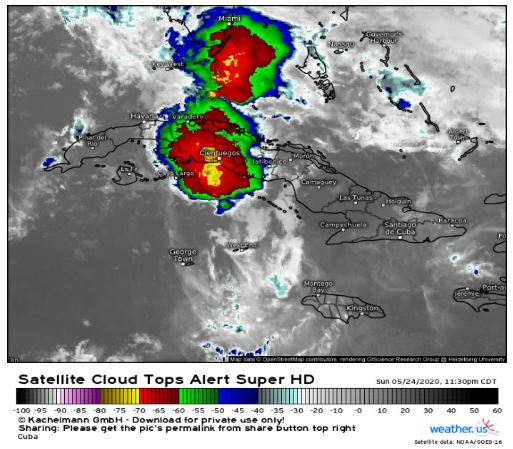Behavior analysis of the mesoscale convective systems in the cuban archipelago
Main Article Content
Abstract
Mesoscale Convective Systems are characterized by the occurrence of strong precipitations that occur in a short period of time and in some cases can cause economic damage as well as the death of people. In Cuba, the study of these phenomena dates back to the 1980s, when the western region of the country was shaken by a system of these characteristics. Since then, several investigations have been carried out on the subject. On March 13, 1993 and May 24, 2020, respectively, two Mesoscale Convective Systems developed over the Cuban archipelago, causing serious damage to the areas affected due to their rapid advance and intensification. The present paper exposes a study carried out about the synoptic and mesoscale environments that gave rise to these phenomena and their life cycles with the help of data from meteorological satellites and surface meteorological stations, as well as their behavior throughout the year taking into account the climatological characteristics, and the consequences that the passage of these systems brought to the countr
Article Details

This work is licensed under a Creative Commons Attribution-NonCommercial 4.0 International License.
References
Alfonso, A. P., & Naranjo, L. R. (1996). The 13 March 1993 severe squall line over western Cuba. Weather and forecasting, 11(1), 89-102.
Borrego, J. A. (2020, 26 de mayo). El infierno que sacudió la madrugada en El Entronque de Guasimal Cubadebate.http://www.cubadebate.cu
Borrego, J.A., Cabrera Pérez, F. (2020, 26 de mayo). Vientos granizados, truenos y fuertes lluvias en el centro de Cuba. Granma.http://www.granma.cu
Carretero, O., & Alonso, R. R. (1998). Sistemas convectivos de mesoescala: climatología mediante imágenes de satélite. Nimbus: Revista de climatología, meteorología y paisaje, (1), 113-136.
Ceperuelo, M., & Llasat, M. d. (s.f.). Predicción de los parámetros radar de las células convectivas.
Circe, M. y F. Martin, 2003: Identificacion y seguimiento automático de estructuras convectivas a partir de datos de radares meteorologicos, Nota técnica. 246 p
Díaz, L. N. (2004). Superstorm 93: A Case Scenario. MeteoGalicia.
Duvel, J. P. (1989). Convection over tropical Africa and the Atlantic Ocean during northern summer. Part I: Interannual and diurnal variations. Monthly weather review, 117(12), 2782-2799.
Gamache, J. F., & Houze Jr, R. A. (1983). Water budget of a mesoscale convective system in the tropics. Journal of Atmospheric Sciences, 40(7), 1835-1850.
González, D. E. (2018, 6 de marzo). La verdadera historia de la Tormenta del Siglo. Cubadebate. http://www.cubadebate.cu
Instituto de Meteorología de la República de Cuba (2020, 24 y 25 de mayo). Estado General del Tiempo. http://www.insmet.cu/
Jiang, D. R. (1990). A Theory for Long-Lived Mesoescale Convective Systems.
Jirak, I. L., Cotton, W. R., & McAnelly, R. L. (2003). Satellite and radar survey of mesoscale convective system development. Monthly weather review, 131(10), 2428-2449.
Lafore, J. P., & Moncrieff, M. W. (1989). A numerical investigation of the organization and interaction of the convective and stratiform regions of tropical squall lines. Journal of the atmospheric sciences, 46(4), 521-544.
Laing, A. G., Fritsch, J. M., & Negri, A. J. (1999). Contribution of mesoscale convective complexes to rainfall in Sahelian Africa: Estimates from geostationary infrared and passive microwave data. Journal of Applied Meteorology and Climatology, 38(7), 957-964.
León, F. M., Mendaza, M. C., & de Esteban Jódal, L. (1994). Estudio de dos sistemas convectivos de mesoescala en el área mediterránea española. Papeles de Geografía, (20), 81-104.
Maddox, R. A., Rodgers, D. M., & Howard, K. W. (1982). Mesoscale convective complexes over the United States during 1981-Annual summary. Monthly Weather Review, 110(10), 1501-1514.
Marshall, T. C., & Rust, W. D. (1993). Two types of vertical electrical structures in stratiform precipitation regions of mesoscale convective systems. Bulletin of the American Meteorological Society, 74(11), 2159-2170.
National Weather Service, NOAA. (1993, 12 de marzo). La vaguada en su esplendor en la noche del 12 de marzo de 1993, a punto de arribar a Cuba. https://weather.us
National Weather Service, NOAA. (2020, 24 de mayo). Imagen IR, donde se observa la influencia sobre Cuba de las altas presiones y la posterior formación del sistema convectivo de mesoescala sobre la región central de Cuba en la noche del 24 de mayo del 2020. https://weather.us
National Weather Service, NOAA. (2020, 25 de mayo). Imagen IR del sistema convectivo de mesoescala, región Central de Cuba en la madrugada del día 25 de mayo del 2020 https://weather.us
Ortiz, A. C. (2014, 19 de abril). Tan peligrosas, como difíciles de predecir. Granma. http://www.granma.cu
Rey, L. (2020, 25 de mayo). Lluvias intensas y tormentas eléctricas en el centro y occidente de Cuba Trabajadores. https://www.trabajadores.cu/
Riosalido, R., & Carretero, O. (1998). Sistemas convectivos de mesoescala: climtología mediante imágenes de satélite.
Senra, Á. P. (2022, 13 de septiembre). Qué son los Sistemas Convectivos de Mesoescala. Cubadebate. http://www.cubadebate.cu
Stolzenburg, M., Marshall, T. C., Rust, W. D., & Smull, B. F. (1994). Horizontal distribution of electrical and meteorological conditions across the stratiform region of a mesoscale convective system. Monthly Weather Review, 122(8), 1777-1797.
Zipser, E. (1992). Utilización de un modelo teórico de ciclo de vida de los Sistemas Convectivos de Mesoescala para mejorar las predicciones a muy corto plazo. Predicción Inmediata. INM (10), pp.23-27.

